Airman First Class Howard LaMont “Monty” Croshaw
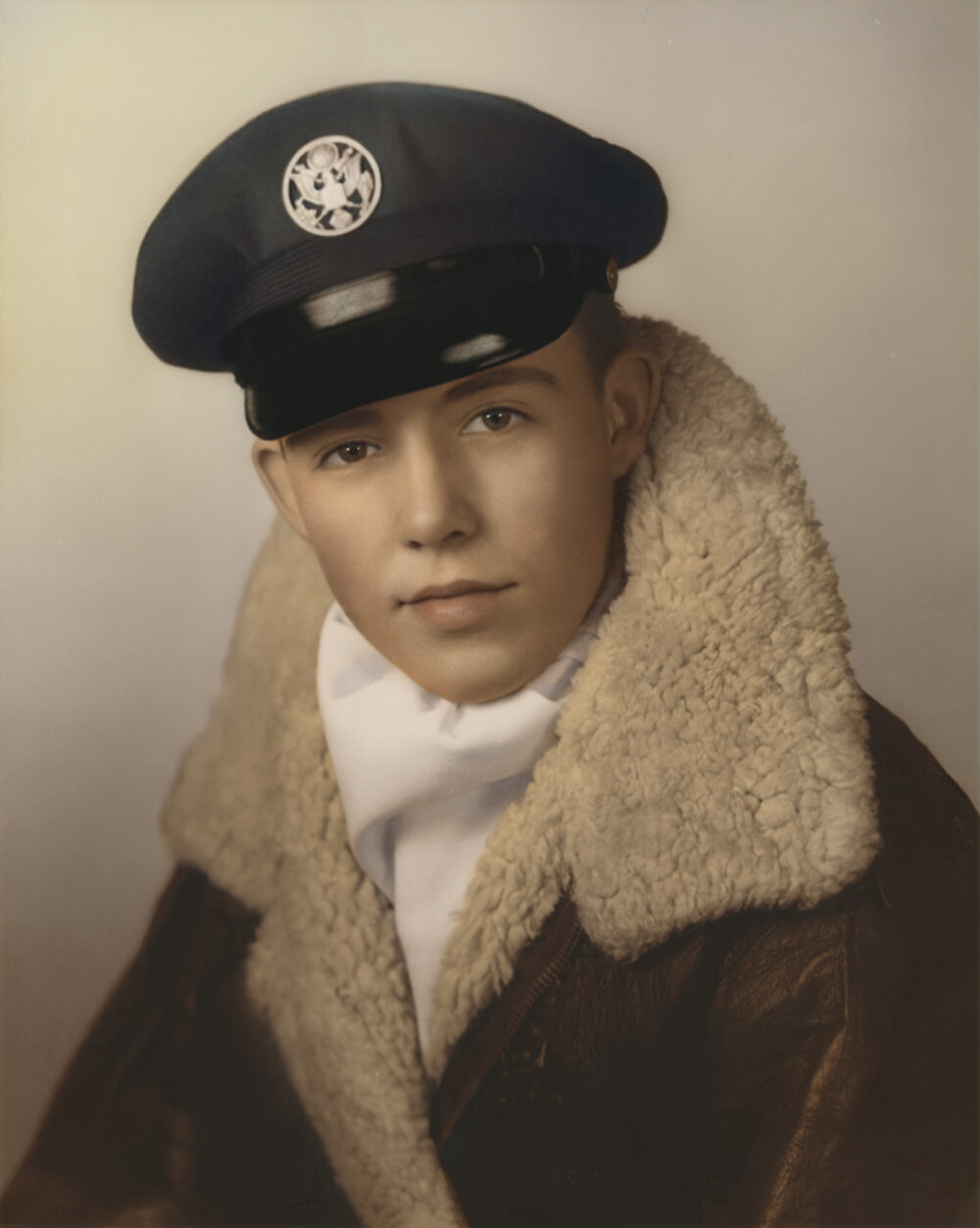
- Unit: 3rd Bomber Wing, 13th Bomber Squadron
- Service Number: AF 19 409 401
- Date of Birth: November 26, 1934
- Entered the Military: December 3, 1951
- Date of Death: July 14, 1953
- Hometown: Logan, Utah
- Place of Death: between Pyongyang and Sinanju, North Korea
- Award(s): Purple Heart, Distinguished Flying Cross, Air Medal with Oak Leaf Cluster, Korean Service Medal, National Defense Service Medal, Korean Presidential Unit Citation, Republic of Korea War Service Medal, UN Service Medal
- Cemetery: Courts of the Missing, Court Five, National Memorial Cemetery of the Pacific, Honolulu, Hawaiʻi . Logan City Cemetery, Logan, Utah
Hidden Valley Middle School (Bluffdale, Utah)
2024/2025
Early Life
Airman First Class Howard LaMont Croshaw was born in Stockton, California on November 26, 1934. Croshaw went by his middle name LaMont and was affectionately known as ‘Monty’ by friends and family.
He was the second of eight children born to Howard Fisher Croshaw and Rosa Clark. His paternal grandparents were John James Croshaw and May Belle Fisher and maternal grandparents were Arthur Benjamin Clark and Ethel Adolphia Shirley. He was preceded in death by a baby sister in 1940 and had six siblings: Carma, John, Alan, Steven, Marilyn, and Connie. In late 1936, the Croshaw family relocated to Logan, Utah where “Monty” was raised until entering the service.
Croshaw’s family ran a grocery store for a while in California and later in Logan from 1939 to 1946. His family’s store was named the Croshaw Grocery and they lived across the street from the market. In the spring of 1946, the family sold the grocery business to return to farming.
After World War II, the Croshaw family took in four young men who were attending college under the G.I. Bill, Bob Einzinger, Al Rogalsky, Lou Catalano, and Jack Theray. In their small, two-bedroom home, the servicemen took one room, LaMont’s sister, cousin, and grandma took the other room. The rest of the family slept in the living room downstairs. This experience may have influenced LaMont (age ten to twelve at the time) to join the military.
In 1948, the Croshaw family purchased land with a small one room log cabin in Juniper, Idaho, where they spent several summers dry farming (growing crops in areas with limited rainfall). When he was not helping with the farm, LaMont developed his marksmanship while hunting jackrabbits and pheasants with his .22.
School
LaMont attended school in Logan, Utah at Wilson Elementary School, Logan Junior High School, and Logan High School. He was a cheerleader who was well-liked by everyone. At Logan High School, he participated in the Reserve Officer Training Corps (ROTC) program and was honored as the Cadet of the Week in December 1950.
During his junior year, LaMont wanted to enlist in the newly formed U.S. Air Force. Having completed just over two years of school, after several discussions with his parents, he chose to leave high school and enlist in the Air Force at age 17. While in the military, he completed his GED and finished his seminary requirements for The Church of Jesus Christ of Latter-Day Saints (LDS).
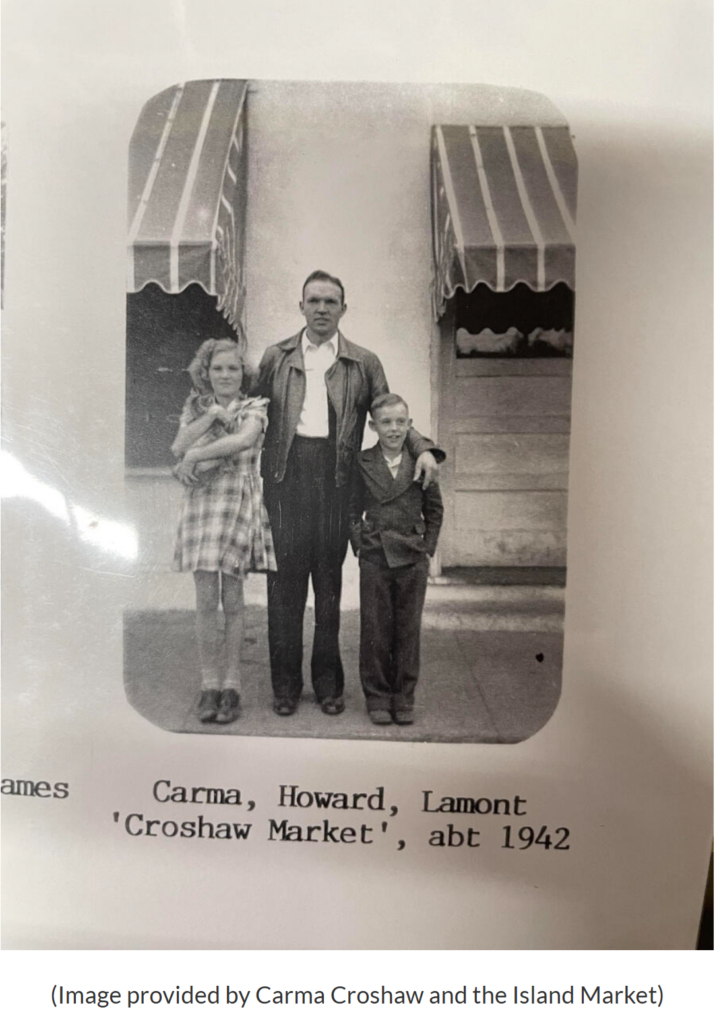

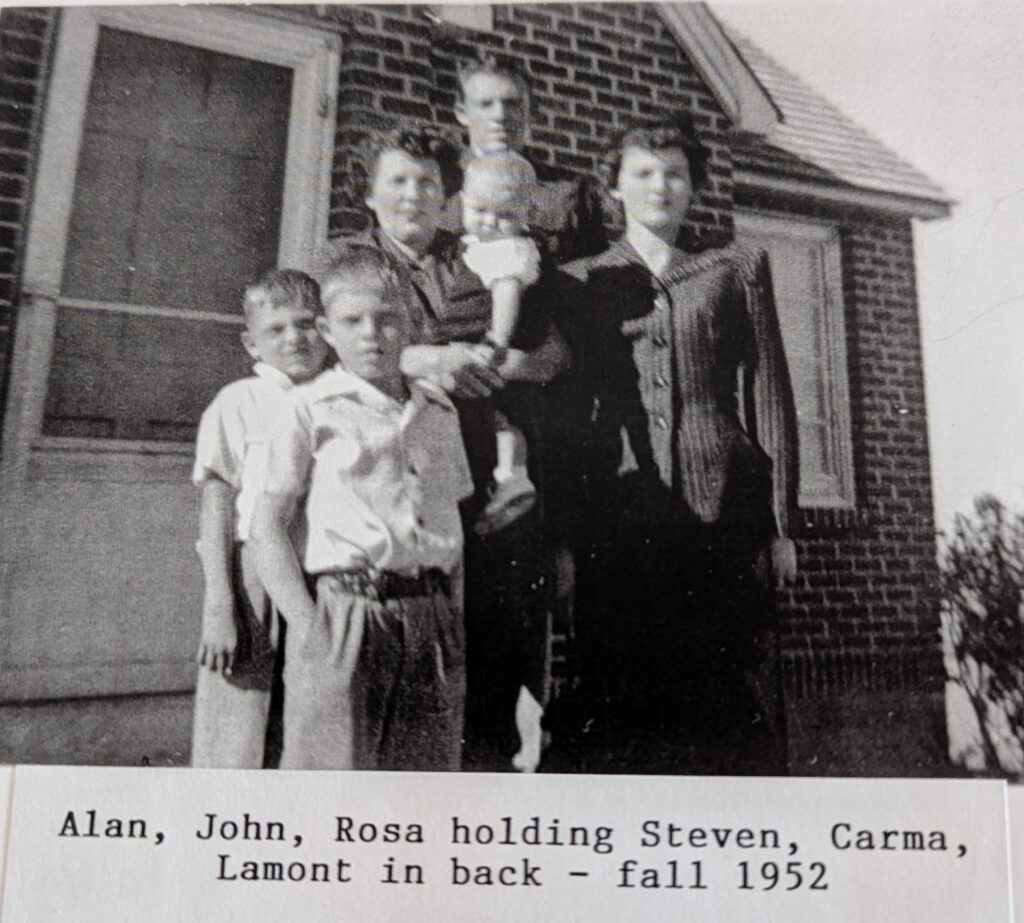
Homefront
In the 1940s and 1950s Logan, Utah was a small community with about 16,000 residents. Logan is the largest city in Utah north of Ogden. Logan and the surrounding area is known as Cache Valley, a region known for its agriculture and dairy production. Cache Valley is also the brand name of several cheeses that are distributed throughout the intermountain west. Logan is also the home of Utah State University, an agricultural university.
Prior to the Korean War, Logan, Utah housed Prisoners of War during World War II and its small airport was used for pilot training.
Military Experience
LaMont Croshaw enlisted in the U.S. Air Force at the age of 17 at Fort Douglas, Utah, on December 3, 1951. His father, Howard, reluctantly signed for him since he was a minor. He was transferred to Sheppard Air Force Base in Texas on December 3, 1951 to begin training with the 3738th and 3747th Training Squadrons. Croshaw was trained as a turret system mechanic and later as a turret system mechanic gunner. A turret system mechanic gunner is one who trains on using different guns in aircraft. Croshaw served as a gunner for B-26 medium bomber planes.
Croshaw was promoted from a private to airman third class on January 28, 1952. Shortly after, on February 8, he transferred to Lowry Air Force Base in Denver, Colorado. There he was assigned to the 3430th Student Squadron (from February 7 to 19, 1952), followed by the 3428th Student Squadron and the 3415 Tactical Training Group (from February 20 to June 18, 1952). He then joined the 3415th Aircraft Gunner Group and participated in officer training with the 3425th Student Squadron from June 19 to July 9, 1952. During his time at Lowry, Croshaw was promoted to airman second class on June 11, 1952.
On July 9, 1952 Croshaw was transferred to Langley Air Force Base in Hampton, Virginia, where he joined the 4400th Combat Crew Training Squadron. His training continued through February 1953 and included an advanced B-26 gunnery school and flight training. During this period, Croshaw was promoted to airman first class on October 21, 1952. Initially a temporary assignment, this role became permanent March 1, 1953 at Kunsan Air Base, Korea.
Korea
During his flight training and schooling, Croshaw stopped at Travis Air Force Base in Fairfield, California, on his way to Haneda Air Base, Japan. He arrived at Haneda on January 13, 1953 to participate in Aircrew Familiarization Training with B-26 planes through a Mobile Training Detachment. While there, Croshaw was assigned to the 13th Bomb Squadron, 3rd Bomber Group known as “The Devil’s Own” where his primary role was as a B-26 Gunner. Croshaw deployed to Kunsan Air Base in Korea on January 22, 1953.The 13th Bomb Squadron –The Devil’s Own –was a squadron whose history spanned 36 years by the time the Korean War ended. A small booklet created by the 13th Devil’s Own and Grim Reapers was dedicated to their fallen comrades, of which Croshaw was one of six members listed. A brief history of the 13th Bomb Squadron notes:
During the three years of the war in Korea, the 13th flew steadfastly and heroically; sortie records were set, only to be broken again, month after month as the war progressed. These records were set by crew members and ground personnel working around the clock to keep planes armed and flying. Missions were flown in all types of weather, fair and foul, and the formations, the low-level recces, and the ground support sorties flown by the Grim Reapers helped account for 31,010 Enemy Vehicles, 337 Locomotives, 2,920 Box Cars, 114 Bridges, 845 Rail Cuts, 816 Road Cuts, 531 Buildings, and an undetermined number of enemy personnel.
All of Croshaw’s missions were completed under the cover of darkness, where the crew sometimes flew 100 feet or less off the ground to hit their targets. Their main mission was to search for, target, and destroy anything to diminish the enemy. Much of these missions resulted in destroying trucks, supply convoys, and trains that were supplying the enemy on the frontlines.
Throughout Croshaw’s time in the Air Force, he was heavily involved in the small branches (local congregation) of The Church of Jesus Christ of Latter-Day Saints (LDS). He served as the Mutual Improvement Association (MIA) song leader and the sacrament meeting chorister. Croshaw worked hard to earn his MIA Award after finishing his seminary requirements.
Letters from Korea
In one of his first letters home from Korea, February 28, 1953, Croshaw wrote, “No, I haven’t fought yet, but it shouldn’t be to [sic] much longer until I’ll be flying combat . . . I might get home some time in July or August.” Croshaw participated in flights and missions beginning on March 20, 1953.
On March 27, 1953, Croshaw said, “I had an uneventful first combat mission. No Flak! This is quite unusual getting no flak. I’m flying No. 2 tomorrow night. There is no need to worry about me Mom. There isn’t hardly any danger at all. We haven’t lost one aircraft for 2 ½ months.”
Croshaw wrote on April 15, 1953, “They started trading prisoners yesterday morning at 0600 so maybe the war will be over before to long. It’s my guess it will be a couple of months yet. Well I’ve got 7 missions in now. On my last one we destroyed 9 trucks. The bombardier got 7 and I got the other 2 with my ‘twin 50’.”
A few days later on April 20, he wrote, “While flying last night I broke the stem out of my watch, broke my earphones, and one of my guns would not fire. However, with the one gun that would fire I destroyed 10 enemy trucks full of ammunition and supplies for the Reds at the front. This makes a total of 13 trucks destroyed by me in the past 9 missions. I’m going for No. 10 tonight . . . Yes I’ve got to fly 50 missions but it won’t be to awfully long until I’ll be home.”
He went on leave to Tokyo at the beginning of May 1953 and returned to Kunsan Air Base on May 17. He sent his family gifts from Tokyo.
In a letter to his sister, Carma, on June 22, 1953 Croshaw wrote, “The rain is slowing down the number of missions flown but is not stoping them completely….Now that I am on the report, it will only be 4 to 6 weeks until I’ll be home. I’ve got 36 in now.”
In a letter home on June 29, 1953, Croshaw stated, “Well 39 of the 50 are completed. Only 11 more to go . . . The rest of my crew (Pilot, Navigator, and Engineer) have all left for the ZOI (Zone of Interior). It will be about 3 or 4 weeks before I leave I guess. I hope it is sooner.”
The following day, June 30, 1953, in another letter he stated, “I’m going for No. 40 tonight. I’m flying with the squadron commander Lt. Col. Cline. We’re going north within 30 miles of the Yalu River.”
A few days later on July 4, 1953 Croshaw wrote home again. “It looks like the rain may stop in another week or so . . . I still have 42 in. Just 8 more to go. I was going to fly tonight but I got canceled because of the weather . . . About 4 or 5 more weeks and I’ll be home. The sooner the better. I’m No. 2 on the flow chart now. It feels good to be on the top at last.”
The flow chart mentioned in this letter was a list of men in order of the number of missions completed. Once they reached 50 and the top of the list, they were the next airman to return home.
Two days later, Croshaw wrote again. Unbeknownst to him or his family, this is the last letter he would send home. “Well I still have 42 missions. The weather has been so bad that we haven’t been able to get off the ground for 3 days. I don’t think it will clear up for 3 or 4 more days either. It may be even longer. It might even be possible that I won’t fly any more before I come home. Who knows?”
Final Mission
There are two different stories about LaMont’s final mission. One was that Croshaw volunteered for this mission so he could get closer to hitting the 50 mission marker in order to head home. Other reports have indicated that his crew had been sent home after completing their time, but Croshaw’s paperwork had gone missing, keeping him at Kunsan Air Base. He volunteered to join a crew gathered from the men left at Kunsan Air Base.
On July 13, 1953, Airman First Class Croshaw joined a night intruder operation in need of a gunner. The plane departed from Kunsan Air Base targeting an enemy supply route between Pyongyand and Sinanju. This area was known as “Purple 4” and in an area called “MiG Alley.” This area was known for its intense air battles and constant enemy fire.
The last known contact of the aircraft with Croshaw and three other aviators aboard, came just after midnight on July 14 when radio contact was made with air controllers with the call sign, “Kodiak.” The aircraft reported that they were inbound to the target area and were not experiencing difficulty. However, the Invader did not return to Kunsan Air Base and was reported missing. Searches for the missing aircraft were cancelled due to bad weather. Captain Stanley B. Haladyna (pilot), First Lieutenant Fred F. Atkinson, Jr. (navigator), Airman First Class Howard LaMont Croshaw (gunner), and Airman Third Class Glen F. Story (engineer) were declared Missing in Action (MIA). The armistice was signed less than two weeks after this mission.
A letter from LaMont’s LDS group leader, William H. McKeel, provided Croshaw’s family with some information about the terrain and area of which the plane went missing including other details about the mission.
I’ll tell you all that I know about the circumstances surrounding Howard’s disappearance. I must tell you that the plane was never found and the search has been called off because of the exceeding rough terrain, a wreckage would be almost impossible to find. I’m enclosing a picture taken over North Korea during a day-light mission although this picture was not taken over the same route which Monty was on, it is typical of most of the terrain found up north. From the picture, the hills do not appear too high or rough, but could you get a closer look you could see how hilly it really is. You asked me if I could tell you if they hit a mountain or how possible it would have been. Since they were on route wrecking run, their minimum altitude on this particular route was between 6,000 and 8000 feet so it would have been almost impossible for them to hit a hill. You asked my opinion if it was weather, engine trouble, or enemy fire, in my honest opinion I think it was ground fire, but keep in mind no one knows for sure. As for being captured, if they left the plane it would be almost certain capture, since that area is close to a main supply route. We’ll know soon if he was captured or not and I pray that he was, since most of the men that are captured are treated fairly well, and there are some things worse.
When last radio contact was made they were off course about 25 miles, they got a fix ‘heading’ and were on their return to the original course and they said everything was okay. That is the last we heard. I know this is practically nothing as far as information is concerned, but I’m so afraid of falsely building up your hopes which happened in our family during the last World war . . .
By the way, Monty’s plane was flying alone that night, this picture I’m sending is misleading since nearly all night runs were made more or less by one plane at a time. From all that I could find out, this was Monty’s first mission with this particular crew and there were no other LDS boys aboard, and from all indications they were going in for the mission instead of coming back . . .
Military Citation
LaMont Croshaw was a skilled marksman and before his death had taken out over 22 different trucks and convoys in his missions. He earned the highest award in the Air Force for valor, the Distinguished Flying Cross. Though the paperwork had been started, Croshaw was declared Missing in Action before receiving the medal. His parents, Howard and Rosa Croshaw received it posthumously.
The citation read:
Airman First Class HOWARD LAMONT CROSHAW distinguished himself by extraordinary achievement while participating in serial flight as a Gunner on a B-26 Attack Bomber, 3d bombardment Wing (Light), Fifth Air force, on 4 May 1953. On that date, Airman CROSHAW displayed outstanding airmanship and marksmanship while on an armed reconnaissance mission in North Korea. A convoy of supply vehicles was sighted and taken under attack in spite of intense and accurate enemy antiaircraft fire. By skillfully using his turret guns, Airman CROSHAW silenced two of the enemy’s antiaircraft positions and destroyed nine enemy vehicles. Airman CROSHAW’S outstanding airmanship and professional skill contributed materially to the singular success of this mission, which accounted for twenty-four vehicles destroyed. Through his high personal courage, technical ability and exemplary devotion to duty, Airman CROSHAW reflected great credit upon himself, the Far East Air Forces and the United States Air Force.
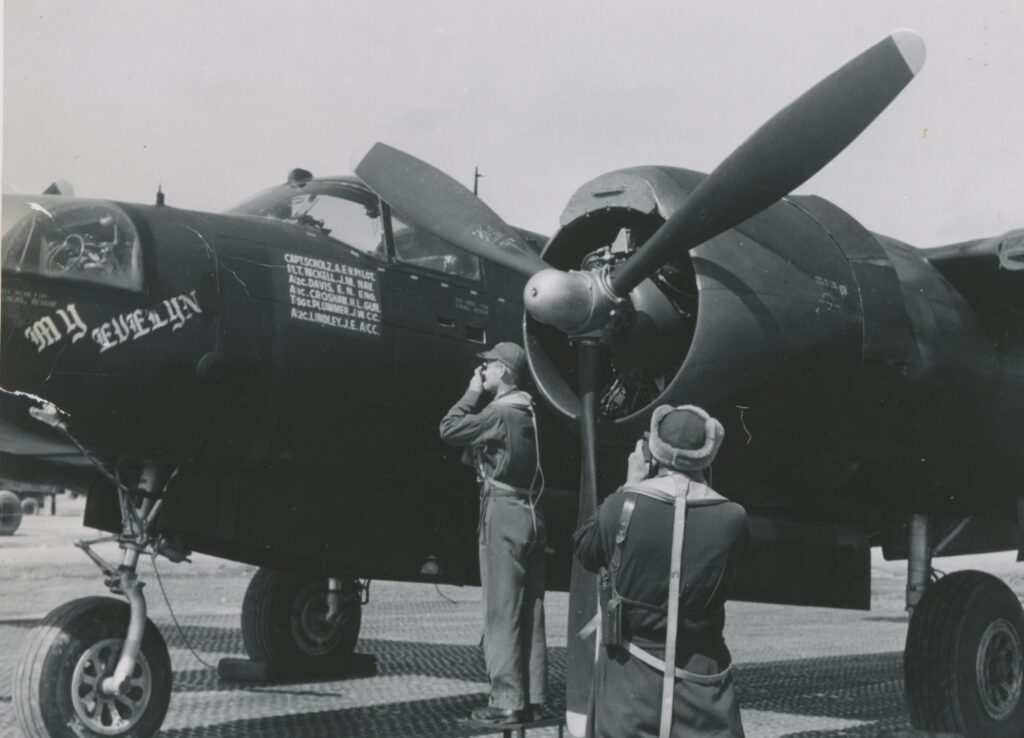
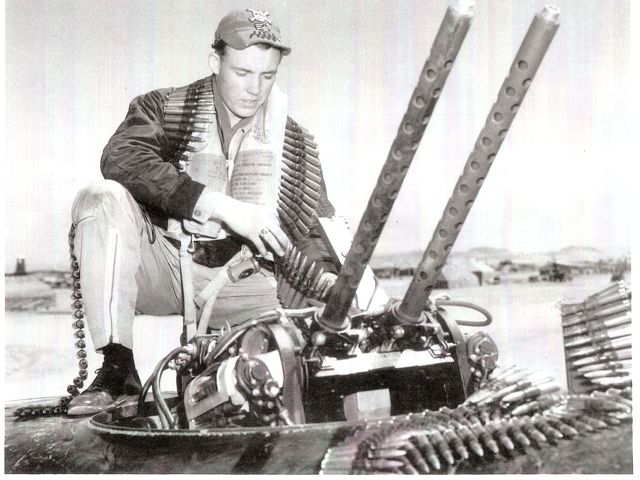
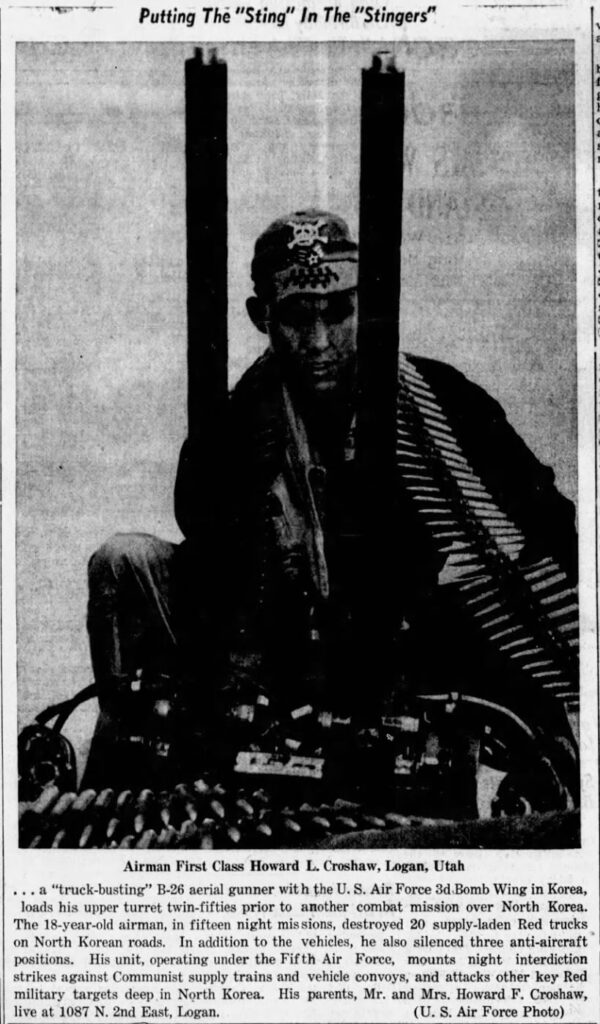
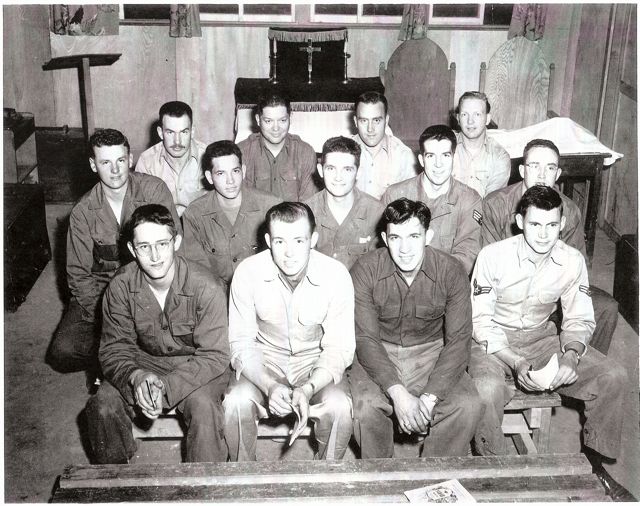
Commemoration
The Croshaw family received a telegram from Western Union on July 15, 1953 informing them that their son, Howard LaMont ‘Monty’ Croshaw and the rest of his four-member crew were Missing in Action. It read, “It is with deep regret that I officially inform you that your son A/1C Howard L Croshaw has been missing since 14 July 1953 as the result of participating in Korean operations. A letter containing further details will be forwarded to you at the earliest possible date. Please accept my sincere sympathy during this time of anxiety.”
The disbelief and anguish was overwhelming for the family. The Croshaw family, especially his mother, held onto hope that he would be found and reunited with them. After receiving the telegram, LaMont’s mother wrote a letter to her son.
Dearest Son,
This morning at about 10 oclock we received word that you were missing in action. I can’t believe it. Only yesterday we got your letter with the “tough guy” picture in it and saying you would soon be home. It can’t be true and yet we have to believe that your plane did not return to base. We decided to write to you and tell you how things are here at home and when you return to your base you will be all caught up on the news.
Our feelings are so mixed up that it will be hard to describe them. I am sort of numb and keep expecting to wake up and find out this has been a bad dream.
As soon as we rec. the telegram we started having calls & visitors. Everyone is so concerned and so many people are praying for you that you just have to be alright. Just for the record people who have telephoned since the paper came out & a few before are: Sarah Lou, Mrs. Lewis, Sister Brent, Aunt Nellie, Helen C, (Clayton is in Calif.) Farners, Tory Merrill, Florie Wiseman, Annie Clark. Those who came out–The Spencers, Sister Esshler, Florence & Ken, Bertha & Joe Wadsworths, Frankhausers, Hunsakers, Israelsens, Shirley & Ruth, Kay & Jo Lene Kinghorns.
We sent a telegram to Carma & Boyd this afternoon. They just arrived in Calif yesterday.
Well Son, I won’t prolong this letter. I hope and pray you will be able to read this. We are going to fast and pray for you all day tomorrow along with our relatives and friends who have a lot of faith. Your name will be on the prayer circle in the temple tomorrow also.
God grant that you may receive this and we will hear that you are alive and well.
All our love,
Mother
On July 19, 1953, Croshaw’s mother wrote another letter to her son.
Dear Son,
Five days you have been missing. How we long to know where you are. I have had some peace in my heart the past two days. I feel there is a good chance that you are all right. The whole ward is praying for you, both separately and together. We are going to the temple wed. night where your name is on the prayer roll. I’m sure the Lord will bless you if you are still living and help you to endure what you have to go through.
We never expect these things to come to us. It is always the other fellow but this time I guess we just weren’t so lucky.
I should write something cheerful because if you get these letters everything will be all right and you will want to know the news from home, but I can’t seem to get my mind on anything else and nothing is important to me except for you to return safely.
We have just about worn out the pictures you have sent and your patriarchal blessing. We feel so badly to think that we have neglected writing lately, even tho it seemed impossible when we were so extremely busy.
You will send a wire to us immediately when you get back won’t you. We are so worried.
Love from all of us,
Mother
Both letters Croshaw’s mother wrote were marked Missing and returned unopened.
In a letter Croshaw’s LDS group leader, William H. McKeel wrote, “I want to take this opportunity to tell you that we really miss Howard, he has made himself a name in our church group, always a fine example of what Mormonism stands for. He has been our Song Leader and plus this he has taken a very active part both in M.I.A. (Mutual Improvement Association) and the church groups.” In this letter he mentioned that there was a search ongoing, but the weather was making it difficult. McKeel also said that if Croshaw had gotten out, that he would most certainly be captured being so far north. He and another member of the church group would visit the family on their way home a few weeks later, hoping that better news would be known.
Less than two weeks after Croshaw’s plane went missing, the armistice was signed and talks of prisoner exchanges were announced. Croshaw’s family, specifically his brothers, Alan and John, and their mother sat around the radio and listened intently, holding onto hope that they would hear Croshaw’s name as one of the ones being exchanged. His sister, Carma, was living in California, checked newspapers in San Francisco. His parents also checked the newspapers for the lists of servicemen who were being exchanged or their remains being brought back. Much to their dismay, their son’s name was never mentioned in any of the newspapers or radio broadcasts.
The Croshaw family received a letter October 16, 1953 from Jim Nickell, a navigator who had flown with Croshaw the majority of the time in Korea. In this letter he stated:
Although I realize there is nothing I can do or say to relieve your misfortune, I feel bound to tell you that no one in this country has a right to be prouder of their son than you do. From Langley through Stead to Korea both Captain Scholz and myself grew to know Howard and to admire him. From the very first we counted ourselves fortunate and having him with us and our regard for him continued only to grow. When I received the news it was with the same feeling as if I had been told that my brother was missing.
Howard and I used to have some long talks on all those matters we shouldn’t have discussed–his family, politics, and religion. In practice and in belief, he followed those principles which he had received in his home, in his school, and in his church. So long as I have known him, his faith has never wavered. This fact, I am confident, will be his blessing now, wherever he is and whatever he might be doing . . .
One Year Later
After one year, the Air Force changed Croshaw’s status from Missing in Action to Presumed Dead. The military investigated and conducted interviews with Prisoners of War (POWs). No one mentioned having contact with Croshaw nor any of the other crew members in captivity, at any holding points, or other places. His effects were sent back to his parents in two cartons on March 16, 1954. To this day, his remains have yet to be recovered.
Croshaw’s mother, Rosa said, “Before the year was up we had received a comfort and very clear feeling that he was with others of our family in heaven and that all was well with him. We found it hard to see his companions return home and fulfill useful lives here, but do feel that he has an important mission where he is.”
Legacy
Many years later, Croshaw’s siblings found memorabilia from the Korean War in their mother’s hope chest. It was filled with letters, photographs, service medals, and a recording of Monty’s voice sent during his time in the military. Much of this has been dispersed amongst his siblings.
Airman First Class Howard LaMont Croshaw is memorialized on Honolulu Memorial at the National Memorial Cemetery of the Pacific. His name is inscribed on the Korean War Veterans Memorial Wall in Washington, D.C. In Logan, Utah, he is memorialized on the cenotaph marker in the Logan City Cemetery, with other family members’ gravestones and plots in the surrounding area. Though his plot does not contain his remains, beneath his headstone are the remains of two cousins who died in their infancy.
On the grounds of Logan High School, a bridge commemorates and honors soldiers who were alumni of the school and did not return home from fighting in World War II, Korea, and Vietnam. LaMont Croshaw’s name appears on one of the plaques.
In 2022, the Croshaw siblings worked with the American Festival Chorus and Orchestra to put together a commemorative video of LaMont’s life and military service for their Veterans Day concert.
For Memorial Day, the Croshaw family gets together at the Logan City Cemetery, encircles the graves of their parents and LaMont, shares memories or stories, and sings patriotic songs or songs about families.
Several of Croshaw’s siblings and descendants have named some of their children, nephews, and grandchildren LaMont as a way to honor him and keep his memory alive.
Memorial Video courtesy of the American Festival Chorus:
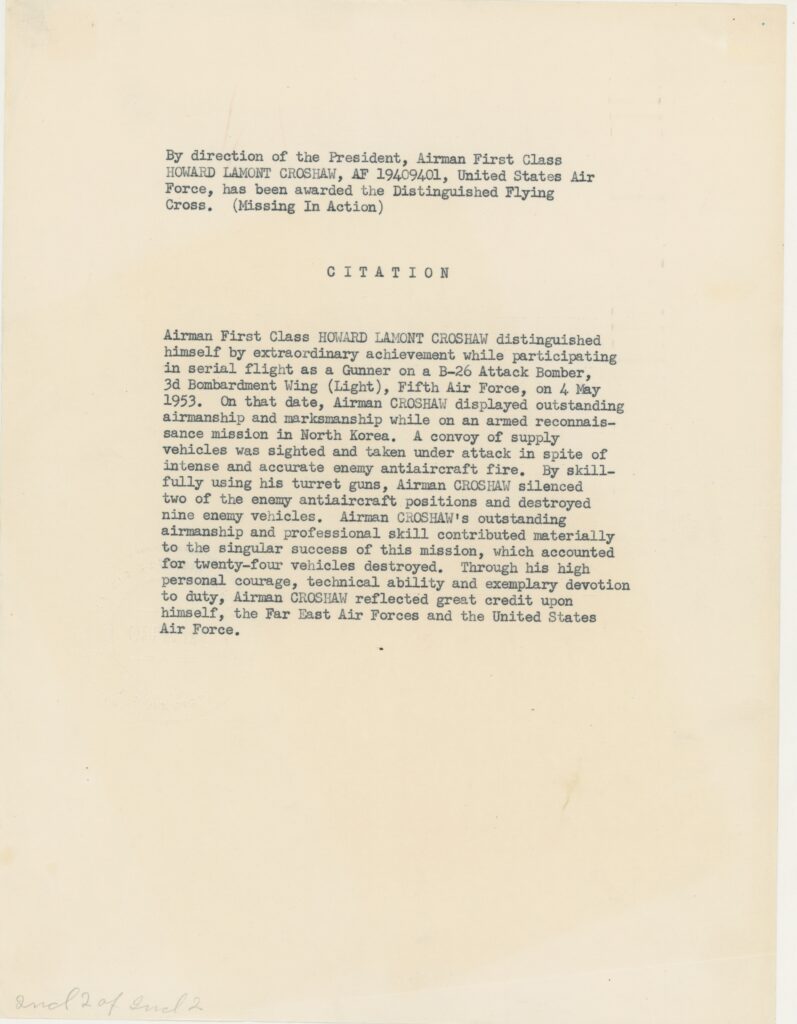


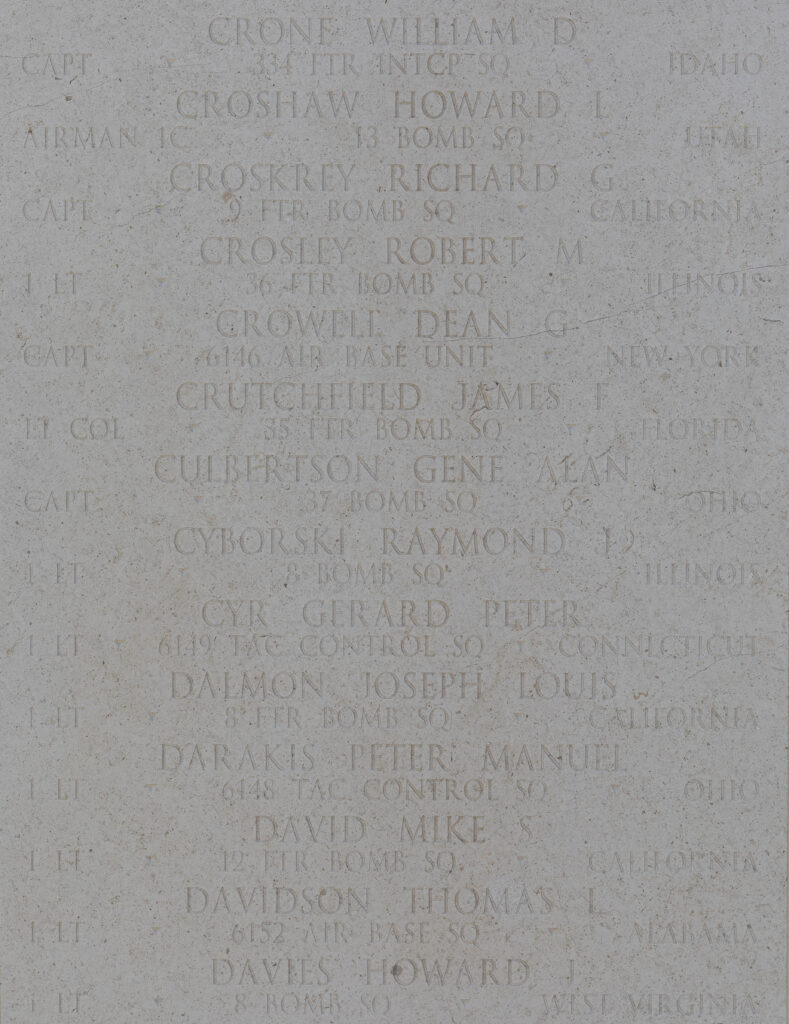
Bibliography
Primary Sources
“About Town.” Logan Herald Journal [Logan, UT], June 3, 1953. Utah Digital Newspapers. https://newspapers.lib.utah.edu/ark:/87278/s6770zb5/28673006.
Choate, Marilyn. Telephone interview with the author. March 21, 2025.
Croshaw, Alan. Personal interview with the author. March 20 and 22, 2025.
Croshaw Family Papers. 1889-1990. Courtesy of the Croshaw Family.
Croshaw, John. Telephone interview with the author. March 22, 2025
Goddard, Amanda. “Logan High School to tear down, Rebuild Memorial Bridge.” The Herald Journal [Logan, UT], January 25, 2025. https://www.hjnews.com/news/community/logan-high-school-to-tear-down-rebuild-memorial-bridge/article_f16d09a6-da7f-11ef-b0b1-676268812560.html.
Howard L Croshaw. Individual Deceased Personnel File. National Archives and Records Administration – St. Louis.
Howard L Croshaw. Official Military Personnel File. National Archives and Records Administration – St. Louis.
Israelsen, Carma Croshaw. Telephone interview with the author. March 21, 2025.
“Logan Flier Bags Trucks in Korea ‘Like Rabbits’” Ogden Standard-Examiner [Ogden, UT], May 5, 1953. Utah Digital Newspapers. https://newspapers.lib.utah.edu/details?id=25863545
Randall, Carla Israelsen. Telephone interview with the author. March 20, 2025.
Utah. Cache County. 1940 US Census. Digital images. https://ancestry.com.
Secondary Sources
“A1C Howard Lamont Croshaw.” Find a Grave. Updated August 7, 2016. Accessed February 21, 2025. https://www.findagrave.com/memorial/167894852/howard-lamont-croshaw.
“A1C Howard Lamont Croshaw.” Find a Grave. Updated July 13, 2016. Accessed February 21, 2025. https://www.findagrave.com/memorial/166922733/howard-lamont-croshaw.
“Air War Korea, 1950-53.” Air & Space Forces Magazine, February 27, 2025. https://www.airandspaceforces.com/article/1000korea/.
“Airplane crash in Logan Canyon on Jan. 7, 1953, 1953-1967.” ArchiveGrid. Accessed April 13, 2025. https://researchworks.oclc.org/archivegrid/archiveComponent/57071058.
“AMN Howard Lamont Croshaw.” Find a Grave. Updated October 12, 2013. Accessed February 21, 2025. https://www.findagrave.com/memorial/118623958/howard-lamont-croshaw.
Cache Valley Story Told 1950’s Style. Logan Historian. March 1, 2018. YouTube. [19:28]. https://www.youtube.com/watch?v=Dgk8PFQsCb0.
Howard Lamont Croshaw. Defense POW/MIA Accounting Agency. Accessed December 31, 2024. https://dpaa-mil.sites.crmforce.mil/dpaaProfile?id=a0Jt000000D1viEEAR.
The Island Market: Logan’s Historic Corner Market. Digital Exhibits, Utah State University. http://exhibits.lib.usu.edu/exhibits/show/the-island-market/history/food-and-shopping-habits-chang/timeline1934-1950.
“Local history – timeline.” Logan Library. Accessed April 13, 2025. https://library.loganutah.gov/research___learn/local_history_timeline.php.
Louis, David. “Courage under fire: Utah National Guard’s Korean War Legacy Part 2.” St. George News [St. George, UT], August 11, 2024. https://www.stgeorgeutah.com/news/local/courage-under-fire-utah-national-guard-s-korean-war-legacy-part-2/article_5f555a8a-b0cf-5f34-8553-4b628fc63c4e.html.
“Plane crash of 1953.” Highway 89 Collection. Accessed April 13, 2025. http://highway89.org/items/show/1617.
Toone, Trent. “Latter-day Saint soldiers who fought in Korean War and compared to book of Mormon story remembered in New short film.” Church News, December 20, 2024. https://www.thechurchnews.com/history-archive/2024/05/27/miracle-at-gapyeong-president-holland-oaks-utah-lds/.
Urrutia, Benjamin. “Korean War and Utah.” Utah History Encyclopedia. Updated 1994. Accessed April 13, 2025. https://www.uen.org/utah_history_encyclopedia/k/KOREAN_WAR.shtml.
Veterans Day memorial tribute for Howard LaMont “Monty” Croshaw. American Festival Chorus. November 18, 2022. YouTube [14:55] https://youtu.be/8KWy9QDN4hQ?si=J-YKQI4u3zR3S_9U.
This profile was researched and created through the Researching Silent Heroes program, sponsored by the American Battle Monuments Commission.

